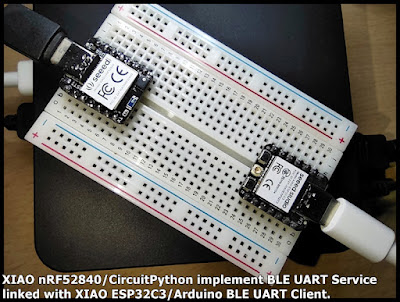XIAO nRF52840/CircuitPython implement BLE UART Service, linked with XIAO ESP32C3/Arduino BLE UART Client.
The BLE GATT Nordic UART Service (NUS) is a custom service that receives and
writes data and serves as a bridge to the UART interface.
ref:
https://developer.nordicsemi.com/nRF_Connect_SDK/doc/2.3.0/nrf/libraries/bluetooth_services/services/nus.html
In this exercise, XIAO nRF52840 Sense running CircuitPython, implement BLE UART Service.
cpynRF_ble.py
"""
Circuitpython BLE exercise
Run on XIAO nRF52840 Sense/CircuitPython 8.1.0-beta.1
Provide an echo service over BLE UART.
Act as BLE UART server,
receive from BLE UART and echo back
ref:
https://learn.adafruit.com/circuitpython-ble-libraries-on-any-computer/ble-uart-example
"""
import os, sys
import time
import board, busio
from adafruit_ble import BLERadio
from adafruit_ble.advertising.standard import ProvideServicesAdvertisement
from adafruit_ble.services.nordic import UARTService
#------------------------
print("========================================")
print(sys.implementation[0], os.uname()[3],
"\nrun on", os.uname()[4])
print("========================================")
ble = BLERadio()
print(ble.name)
uart = UARTService()
advertisement = ProvideServicesAdvertisement(uart)
while True:
ble.start_advertising(advertisement)
print("Waiting to connect")
while not ble.connected:
pass
print("Connected")
while ble.connected:
line = uart.readline()
if line:
print(type(line), line)
stringout = str(line)
uart.write(stringout.encode("utf-8"))
In the BLE client side, basically copy from my ole exercise BLE UART Communication between XIAO ESP32C3 (client/central) and nRF52840 (server/peripheral), in Arduino Framework.
XESP32C3_BLE_client.ino/*
* https://coxxect.blogspot.com/2022/10/ble-uart-communication-between-xiao.html
*
* Modify Examples from XIAO_ESP32C3
* > ESP32 BLE Arduino
* > BLE_client
* Run on Xiao ESP32C3.
* With UUID of Nordic UART Service (NUS), to work with
* XnRF52_bleuart_OLED_Terminal run on Xiao nRF52840 Sensse.
* Read from Serial and send to BLE UART server/peripheral.
*/
#include "BLEDevice.h"
//#include "BLEScan.h"
// UUID of Nordic UART Service (NUS)
#define SERVICE_UUID "6E400001-B5A3-F393-E0A9-E50E24DCCA9E"
#define CHARACTERISTIC_UUID_RX "6E400002-B5A3-F393-E0A9-E50E24DCCA9E"
#define CHARACTERISTIC_UUID_TX "6E400003-B5A3-F393-E0A9-E50E24DCCA9E"
// The remote service we wish to connect to.
static BLEUUID serviceUUID(SERVICE_UUID);
// The characteristic of the remote service we are interested in.
static BLEUUID charUUID_RX(CHARACTERISTIC_UUID_RX);
static boolean doConnect = false;
static boolean connected = false;
static boolean doScan = false;
static BLERemoteCharacteristic* pRemoteCharacteristic_RX;
static BLEAdvertisedDevice* myDevice;
static void notifyCallback(
BLERemoteCharacteristic* pBLERemoteCharacteristic,
uint8_t* pData,
size_t length,
bool isNotify) {
Serial.print("Notify callback for characteristic ");
Serial.print(pBLERemoteCharacteristic->getUUID().toString().c_str());
Serial.print(" of data length ");
Serial.println(length);
Serial.print("data: ");
Serial.println((char*)pData);
}
class MyClientCallback : public BLEClientCallbacks {
void onConnect(BLEClient* pclient) {
}
void onDisconnect(BLEClient* pclient) {
connected = false;
Serial.println("onDisconnect");
}
};
bool connectToServer() {
Serial.print("Forming a connection to ");
Serial.println(myDevice->getAddress().toString().c_str());
BLEClient* pClient = BLEDevice::createClient();
Serial.println(" - Created client");
pClient->setClientCallbacks(new MyClientCallback());
// Connect to the remove BLE Server.
pClient->connect(myDevice); // if you pass BLEAdvertisedDevice instead of address, it will be recognized type of peer device address (public or private)
Serial.println(" - Connected to server");
pClient->setMTU(517); //set client to request maximum MTU from server (default is 23 otherwise)
// Obtain a reference to the service we are after in the remote BLE server.
BLERemoteService* pRemoteService = pClient->getService(serviceUUID);
if (pRemoteService == nullptr) {
Serial.print("Failed to find our service UUID: ");
Serial.println(serviceUUID.toString().c_str());
pClient->disconnect();
return false;
}
Serial.println(" - Found our service");
// Obtain a reference to the characteristic in the service of the remote BLE server.
pRemoteCharacteristic_RX = pRemoteService->getCharacteristic(charUUID_RX);
if (pRemoteCharacteristic_RX == nullptr) {
Serial.print("Failed to find our characteristic UUID: ");
Serial.println(charUUID_RX.toString().c_str());
pClient->disconnect();
return false;
}
Serial.println(" - Found our characteristic");
// Read the value of the characteristic.
if(pRemoteCharacteristic_RX->canRead()) {
std::string value = pRemoteCharacteristic_RX->readValue();
Serial.print("The characteristic value was: ");
Serial.println(value.c_str());
}
if(pRemoteCharacteristic_RX->canNotify())
pRemoteCharacteristic_RX->registerForNotify(notifyCallback);
connected = true;
return true;
}
/**
* Scan for BLE servers and find the first one that advertises the service we are looking for.
*/
class MyAdvertisedDeviceCallbacks: public BLEAdvertisedDeviceCallbacks {
/**
* Called for each advertising BLE server.
*/
void onResult(BLEAdvertisedDevice advertisedDevice) {
//Serial.print("BLE Advertised Device found: ");
//Serial.println(advertisedDevice.toString().c_str());
// We have found a device, let us now see if it contains the service we are looking for.
if (advertisedDevice.haveServiceUUID() && advertisedDevice.isAdvertisingService(serviceUUID)) {
BLEDevice::getScan()->stop();
myDevice = new BLEAdvertisedDevice(advertisedDevice);
doConnect = true;
doScan = true;
} // Found our server
} // onResult
}; // MyAdvertisedDeviceCallbacks
void setup() {
Serial.begin(115200);
Serial.println("Starting Arduino BLE Client application...");
BLEDevice::init("");
// Retrieve a Scanner and set the callback we want to use to be informed when we
// have detected a new device. Specify that we want active scanning and start the
// scan.
BLEScan* pBLEScan = BLEDevice::getScan();
pBLEScan->setAdvertisedDeviceCallbacks(new MyAdvertisedDeviceCallbacks());
pBLEScan->setInterval(1349);
pBLEScan->setWindow(449);
pBLEScan->setActiveScan(true);
//pBLEScan->start(5, false);
pBLEScan->start(0, false);
} // End of setup.
// This is the Arduino main loop function.
void loop() {
// If the flag "doConnect" is true then we have scanned for and found the desired
// BLE Server with which we wish to connect. Now we connect to it. Once we are
// connected we set the connected flag to be true.
if (doConnect == true) {
if (connectToServer()) {
Serial.println("We are now connected to the BLE Server.");
} else {
Serial.println("We have failed to connect to the server; there is nothin more we will do.");
}
doConnect = false;
}
// If we are connected to a peer BLE Server, update the characteristic each time we are reached
// with the current time since boot.
if (connected) {
/*
String newValue = "Time since boot: " + String(millis()/1000);
Serial.println("Setting new characteristic value to \"" + newValue + "\"");
// Set the characteristic's value to be the array of bytes that is actually a string.
pRemoteCharacteristic_RX->writeValue(newValue.c_str(), newValue.length());
*/
if (Serial.available() > 0) {
int incomingByte = Serial.read();
Serial.println(incomingByte, DEC);
if (connected) {
pRemoteCharacteristic_RX->writeValue(incomingByte);
}
}
}else if(doScan){
BLEDevice::getScan()->start(0); // this is just example to start scan after disconnect, most likely there is better way to do it in arduino
}
delay(1000); // Delay a second between loops.
} // End of loop

Comments
Post a Comment